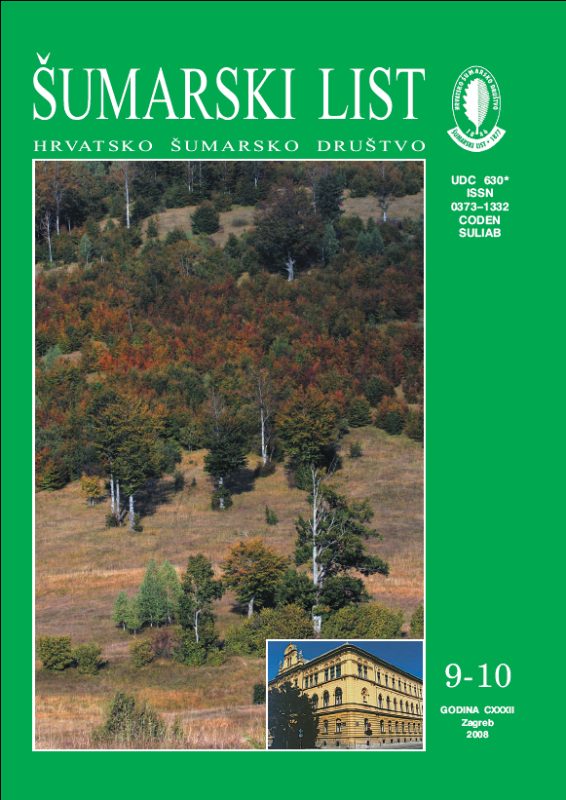
broj: 9-10/2008
pdf (14,1 MB) |
|
||||||||||||||
| RIJEČ GLAVNOGA UREDNIKA | ||
| Branimir Prpić | ||
| THE EDITORIAL BOARD AND THE AUTHORS OF THE ARTICLES IN “FORESTRY JOURNAL” RECEIVE SOME EXCELLENT NEWS PDF HR EN | 389 | |
| IZVORNI ZNANSTVENI ČLANCI | ||
| Seletković, A., R. Pernar, A. Jazbec, M. Ančić | UDK 630* 587 + 588 (001) | |
| Accuracy Of High Spatial Resolution Satellite Images Classification For Forestry Needs pdf HR EN | 393 | |
| Pernar, N., D. Bakšić, V. Bobić, I. Perković | UDK 630* 114.2 + 116 (001) | |
| Soil Condition in Microdepressions of Žutica Forest pdf HR EN | 405 | |
| Klobučar, Damir | UDK 630* 585 + 569 (001) | |
| Using Second order Histograms to Estimate Relative Stand Density pdf HR EN | 419 | |
| Summary: The paper continues on past research into the application of digital stand scene processing and digital ortophoto processing for the needs of forest management. Black-and-white aerial photographs obtained during cyclic surveying of the Republic of Croatia were used for this purpose at an approximate scale 1:20,000 and 60 % overlap. Research was based on the example of the management unit “Jamaričko Brdo” of Lipovljani Forest Office. The most commonly used parameter for quantitative stand descriptions is density. Since the application of digital processing techniques of stand scenes in the last ten years has resulted in the development of new methods of stand density evaluation, an additional possibility was investigated of cyclic photograph application by constructing second order histograms and establishing their relationship with three relative density categories. First order histograms represent a graphic display of the proportion of some numerical values in the pixels of a digital photograph. Shades of gray ranging from 0 to 225 are found on the horizontal histogram axis, and the total number of pixels with these shades is found on the vertical axis. Texture measures calculated only by means of the first order histogram data are deficient because they do not give information related to the relative relationship between the pixels themselves. Texture may be described by measuring the smudginess (width) of a histogram around the main diagonal. Such type of textural data does not relate only to intensity distribution (gray scale) but also to the position of pixels with the same or similar values. Namely, instead of only one point, any pair of picture points may be observed in a similar way, whose mutual position is determined with a relation. In this case, the assumed random experiment becomes two-dimensional, and evaluation or estimation of a probability density function is obtained from a second order histogram. This is the reason that researchers in the field of remote sensing use data obtained from second order histograms to analyze texture and perform classifications. First order histograms are less frequently used. Texture features obtained with second order histograms are used in forestry remote sensing, especially for purposes of texture classification or segmentation, but are rarely used for stand parameter estimation. This research indicates yet another possibility of applying digital image analysis to the assessment of relative density and stand condition. Second order histograms may be used to evaluate stand density. Three basic histogram shapes were constructed which can be associated with the related density categories. Cyclic aerial photogrammetric survey of the Republic of Croatia is an exceptionally important project for space management. Hence, the application of second order histograms in remote sensing for the needs of forestry and for forest management in particular, shows continuity of research into the use of cyclic imaging in forestry. At the same time, it is yet another contribution of forestry to this project. According to the available literature treating this issue, research in the past generally involved histogram analysis for the purpose of automatically recognizing crowns in the images during the vegetation period. Histogram analysis, especially in pictures obtained during vegetation dormancy, i.e. when vegetation is without leaves, is a relatively new approach. Procedures of digital picture analysis are still imperfect and cannot fully replace classical procedures. Consequently, integrating digital and visual methods in decision making (with the goal of sustainable forest management) is considered appropriate. Key words: cyclic records; density; first and second order histograms; digital ortophoto; texture | ||
| Ballian, D., B. Giersberg, U. Tröber | UDK 630* 165 (001) | |
| Genetic Variability of Common Yew (Taxus baccata L.) in Bosnia and Herzegovina pdf HR EN | 431 | |


